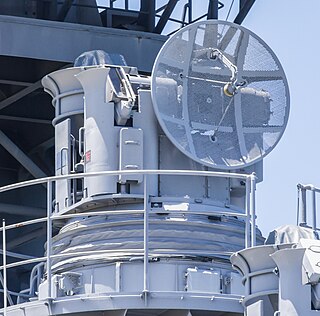
The Tacoma class of patrol frigates served in the United States Navy during World War II and the Korean War. Originally classified as gunboats (PG), they were reclassified as patrol frigates (PF) on 15 April 1943. The class is named for its lead ship, Tacoma, a Maritime Commission (MARCOM) S2-S2-AQ1 design, which in turn was named for the city of Tacoma, Washington. Twenty-one ships were transferred to the British Royal Navy, in which they were known as Colony-class frigates, and twenty-eight ships were transferred under Lend-Lease to the Soviet Navy, where they were designated as storozhevoi korabl, during World War II. All Tacoma-class ships in US service during World War II were manned by United States Coast Guard crews. Tacoma-class ships were transferred to the United States Coast Guard and various navies post-World War II.

The Japan Maritime Self-Defense Force, abbreviated JMSDF, also simply known as the Japanese Navy, is the maritime warfare branch of the Japan Self-Defense Forces, tasked with the naval defense of Japan. The JMSDF was formed following the dissolution of the Imperial Japanese Navy (IJN) after World War II. The JMSDF has a fleet of 154 ships, 346 aircraft and 50,800 personnel.

The Japan Coast Guard is the coast guard of Japan.

USS Carson City (PF-50), a Tacoma-class frigate in commission from 1944 to 1945, thus far has been the only ship of the United States Navy to be named for Carson City, Nevada. She later served in the Soviet Navy as EK-20 and in the Japan Maritime Self-Defense Force as JDS Sakura (PF-10), JDS Sakura (PF-290) and as YAC-16.

JDS Wakaba (DE-261) was the former Imperial Japanese Navy ship Nashi, an escort destroyer of the Tachibana sub-class of the Matsu class built for the Imperial Japanese Navy during the final stages of World War II. Nashi was sunk in July 1945, but salvaged in 1954 and refitted to join the Japan Maritime Self-Defense Force in 1956 as Wakaba, later being utilised as a radar trials ship, but stricken in 1971 and scrapped in 1972-1973.

The BRP Rajah Humabon (PS-11) was a former destroyer escort of the United States Navy and a former frigate of the Philippine Navy. She was the last World War II-era destroyer escort/frigate active in her fleet, and one of the oldest active warships in the world, until 15 March 2018 when she was formally decommissioned after 75 years. She was one of three ex-USN Cannon-class destroyer escorts that served the Philippine Navy, the others being BRP Datu Sikatuna (PF-5/PS-77) and BRP Datu Kalantiaw (PS-76).
The BRP Datu Sikatuna (PF-5) was one of the three ex-USN Cannon-class destroyer escorts that served with the Philippine Navy, the others being BRP Datu Kalantiaw (PS-76) and BRP Rajah Humabon (PF-11).
The second USS Bath (PF-55) was a United States Navy Tacoma-class frigate in commission from 1944 to 1945 which later served in the Soviet Navy as EK-29 and the Japanese Maritime Self-Defense Force, with her Japanese name reported by various sources as JDS Maki (PF-18) and JDS Maki (PF-298), and later as YTE-9.

JS Kurama (DDH-144) was the second ship of the Shirane-class destroyer in service with the Japan Maritime Self-Defense Force (JMSDF).

FCS-1 was a Japanese ship gun fire-control system (GFCS).

JDS Nagatsuki (DD-167) was the fourth ship of Takatsuki-class destroyerss. She was commissioned on 12 February 1970.

JDS Mochizuki (DD-166) was the third ship of Takatsuki-class destroyerss. She was commissioned on 25 March 1969.

The Ariake-class destroyer is a class of destroyers of the Japan Maritime Self-Defense Force. Two ships of the Fletcher class were lent by the United States Navy and were in commission from 1959 until 1974.

The Asakaze-class destroyer is a class of destroyers of the Japan Maritime Self-Defense Force. Two ships of the Gleaves class were lent by the United States Navy and were in commission from 1954 until 1969.

OPS-14 is a two-dimensional radar manufactured by Mitsubishi Electric. It is mainly mounted on the Maritime Self-Defense Force's self-defense ship as an anti-aircraft search radar. Variations include OPS-14B and OPS-14C.

OPS-18 is a two-dimensional radar manufactured by Japan Radio Company. It is installed as an anti-water search radar on the Maritime Self-Defense Force's escort ship. Variations include OPS-18-1 and OPS-18-3.

The Mine Warfare Force belonged to the minesweeping force for the self-defense fleet of the Maritime Self-Defense Forces. Its main task is to lay naval mines in the event of an emergency, and it also help to dispose mines installed during World War II.

The Safety Security Force, also simply known as the Coastal Security Force, was an organization under the jurisdiction of the National Safety Agency, and existed from 1 August 1952 to 30 June 1954 in Japan. It was a maritime security agency established for the purpose of territorial waters security. It was the successor to the Maritime Safety Agency and the predecessor of the Maritime Self-Defense Force.
















